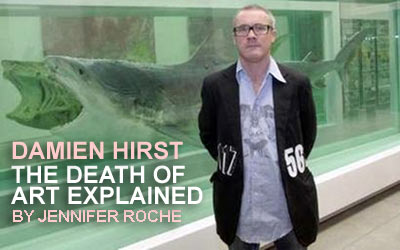Culture
Damien Hirst: The Death of Art Explained

As Wall Street tanks, the Art Market soars. The Damian Hirst auction at Sotheby’s London (Sept. 15-16, 2008) raked in $198 million (£111 million), creating a new jaw-dropping record for a one-artist sale. Hirst’s own record for the highest price he has yet fetched for one of his pieces was also surpassed at this sale with a whopping $18.8 million (£10.3 million) for The Golden Calf. This piece comprises an entire real calf whose horns and hooves have been painted in 18-carat gold and then displayed in formaldehyde in a silicone case that is mounted on a Carrara marble plinth! Hirst’s new masterful interpretation of traditional still life?
What? Has the world gone mad? Why would such works of art sell at unprecedented prices when Wall Street titans sink, some not even getting the much coveted prize of a US government life raft? Further, what is all the hype about Hirst selling new work from the studio directly to the auction house?
Firstly, the extreme volatility in the markets forces investors to seek safe havens. For some time skyrocketing prices for contemporary art have attracted investors from outside of the art world—some are admittedly not even remotely interested in the art except for its market value. What is truly bizarre is that contemporary art has become for some a haven for their cash in troubled times, bringing art to the level of gold or bonds. Unlike stocks, art is a tangible object and as confidence (the essential key to capitalism) in the financial markets erodes, an object or better yet the artist’s name appears to some as unsinkable. Think star power. This is why Time magazine recently had Damian Hirst plastered on the cover under the title Artist as Rock Star. The buzz around Hirst’s recent sale emphasizes how troubling the global asset bubble burst going on around the global markets is right now. Will the hot air manufactured in the art market keep these investors afloat? It’s a gamble. And if you had millions would you in these times worship a golden calf? In Nicolas Poussin’s Adoration of the Golden Calf, one only needs to look at his masterful use of color—how it is balanced and restrained—to see the difference between great art and Hirst’s carnival showmanship.
The other uproar about Hirst concerns how the art market works within the studio, gallery, auction house, museum and art collectors’ showroom. Or at least how it used to, and how its own functioning is due to change post this Hirst sale. Never before has a living artist sold new work direct from the studio to the auction floor. Why? It’s because of the dealer-artist relationship. Before the Hirst auction, there has always been the tradition of a dealer acting as the sole business contact between the artist and the outside world. Many times (not always, but quite often), it would be the dealers, who, after many studio visits, frequenting student shows and emerging gallery spaces, discover artists and then help them along in their careers, by introducing them to important collectors, influential curators, other artists and critics. The kickback is their commission, and perhaps life-long representation at the dealer’s gallery. In the old days, it could be argued that for many dealers the real kickback was the thrill of discovering a great creative mind and bringing it to the world. The art world was not the world of Wall Street, and it didn’t pack the financial punch it does nowadays.
Apart from the art market, who is this Damian Hirst fellow anyway? For me, he can be understood as a cultural bell-weather or the proverbial canary in the coal mine. The signal he sends: the art world at large is a “dead herring in the moonlight. It is shiny, but it stinks!” Hirst’s controversial pieces have outraged some and delighted others. They say he offers morality art. Huh? I thought that was for wonderful painters like William Hogarth, and his satirical moral telling.
For some time art has moved away from the traditional objective of perfecting illusion. For centuries, this was art’s main thrust. Regardless of the picture’s purpose—religious, history painting, portraiture, still life (the great Academies of Europe listed their importance in that descending order), artists strove to depict reality in the most life-like, compelling manner possible. Inevitably, the creative impulse in man became hopelessly bored with this repetition of a theme, and sought to shake things up. Artists began making their own reality, and threw out the rule book about the time of the horrific World Wars I and II.
The devastation caused by these conflicts, as well as industrialization and increased mechanization, further convinced artists to pursue new bold paths. Cubism was at the heart of this “new way of seeing” with its head honcho Picasso. Close on the heels came Surrealism and Dadaism. Damian Hirst comes directly out of this self-referential cocoon. He is the offspring of Duchamp and Man Ray, who frankly did what he does a lot better, but they earned a lot less doing it. For those who argue that Hirst has revolutionized the art world in his new satirical language, I say, “what’s old is new again,” followed quickly by “been there, done that.” After years of really bad abstraction, people have become bored again with not finding obvious defined shapes with pictorial meaning. Back to Dada says Hirst.
The only difference with Hirst is that there is a lot more capital around to allow him to play in his romper room. With wild amounts of money, you can add to the cult of celebrity touches of glamour, and de-luxe vernissages. Man Ray or Duchamp did not die wealthy men. Their satire peddling only earned them a small crowd of chattering elites who praised them for their genius. Their payday came in the form of museum shows and dealer attention. Their age was not quite as decadent as our age. Hirst’s apex communicates everything about the 90s and the early 2000s: excess, greed, bubbly-headed teenagers running the show. As the air rushes out of the hedge fund/mortgage- backed security/sub-prime loan hot air balloon, and the derivative swaps stop to swap and fall flat on the ground with less worth than the paper on which they were written, can we hope to learn any lessons? Probably not. Likewise, will Hirst’s art stand the test of time? For any mature, level-headed person with a discerning eye, one is lead to the same conclusion. Probably not.
The key players in the art world are increasingly impoverished with no obvious goal in sight, save profit. The bigger the better. And what does Hirst have to say for himself? Not much, I am afraid. One of his more memorable quotes: “greed is good for artists.” Or when Hirst was interviewed at his studio once, and watching an assistant paint his polka dot pieces, he quipped, she can f—king paint. Yes, he has someone else do the painting for him! Granted, it’s hardly surprising that works of art should become topics of conversation, and some controversy should ensue when matters of taste are at stake, but this is beyond belief.
Do I sound too cynical? Can I not praise something about the art world darling? Well, he is street smart. Hirst’s true maniacal genius lies in (as well as those around him such as his collector Saatchi and his manager Dunphy who before Hirst managed circus performers and exotic dancers!) his ability to maneuver with the shrewdness of a cat in the new global economy and the postmodernism/installation non-artworld. Yes, they are shrewd. Hirst grasps where we are, and what people want. As does Saatchi. (I can’t help but contrast Saatchi with the past collectors who became known and respected only after years of acquisitions, carefully brokered deals and relationships with dealers and curators—I am experienced mainly with the great American collections of Henry Clay Frick, Andrew Mellon, Isabella Stewart Gardner, and Samuel H. Kress. These collectors were carefully guided directly and indirectly by keen connoisseurs such as the Jewish-American Renaissance expert Bernand Berenson or Britian’s famous Dutch-Jewish dealer Joseph Duveen). Unfortunately, now if you’ve got the cash and the inclination: Wham! Bam! Thank you, Ma’ am! You’ve got yourself a star-studded collection. You’re a black-velvet, rhinestone superstar!
While the media trips all over Hirst, and the elite collect golden calves, why care? You only have to think of the thousands of masterpieces across the globe that have met the standards of time and may need restoration or proper conservation to preserve them for posterity. Why are millions of dollars not pouring into conservation funds to maintain these pieces of truly great art? It’s not as fun as sitting in an auction room with a paddle flashing your wealth. As we see our monuments’ and art works’ glow darkened under grime and neglect, these objects still are able to brace gracefully under pollution and mismanagement. But why should they? You only have to go to Florence to see what I’m talking about. When is the Duomo going to be cleaned and properly presented (without scaffolding) to the world at large? Or where is the outcry when historic monuments in the south of France are attacked with cruel graffiti. If you think I’m being Eurocentric, I was one of those art lovers who felt her heart sink when learning about the horrendous looting and damage done to the Iraqi art monuments and artifacts; these objects of irreplaceable value and artistic merit were treated with barbaric neglect. Or what of the ancient cities such as Carthage that seem to be crumbling with no conservators in sight.
When a character like Hirst rises, and the art world bows to his “incandescently brilliant mind”, we all suffer. When the art world warehouses its reason, and doesn’t sound the cultural alarm bell, we all risk succumbing to a carnival bearded-lady mentality. The next time you flip through your old art history text, journeying through centuries of artworks, and you recall the heights to which the human person is capable of soaring within his creative mind, remember that now, too, Damian Hirst has entered into the syllabus of art history, and inwardly we weep.
Jennifer Roche has a degree in the history of art and has worked at the Frick Art Collection in New York, as well as elsewhere in the art world. She welcomes your comments at [email protected]
By AT 10.13.08 08:55PM
I would love to know who, or what group, made these purchases. I’m wondering if this isn’t just money laundering… why is this crap worth $100 million? There was a kite shop on the street level under my office some years ago… I never understood how they stayed in business, rents on that street were sky high. I found out one day when the FBI was arresting the middle-eastern owners for their part in a global money laundering scheme. Seems the perennial huge net losses and occasional $50,000 kite sale was curious.
Check out another of his “masterpieces,” could this be satanic?
“The Sacred Heart of Jesus,” consisting of a bull’s heart pierced with assorted surgical instruments suspended in formaldehyde, at the Hilario Galguera gallery in Mexico City, Feb. 23, 2006. It was part of Hirst’s first show in Mexico, titled “Mors Dei” (“The Death of God” in Latin).
http://abcnews.go.com/International/popup?id=3234825&contentIndex=1&start=false&page=17
By AT 10.14.08 08:11PM
Reminds me of Andy Warhol’s quote: “Art is what you can get away with.” It is now, certainly, as the success of a snake-oil salesman like Hirst proves. His rise is proportional to how low the art world has sunk. As Jacques Barzun has argued, the art world is in a state of full-blown decadence when pranks and provocations are the coin of the realm.








By Dave AT 10.13.08 06:01PM
This reminds me of a quote by Chesterton:
“The artistic temperament is a disease that afflicts amateurs.”